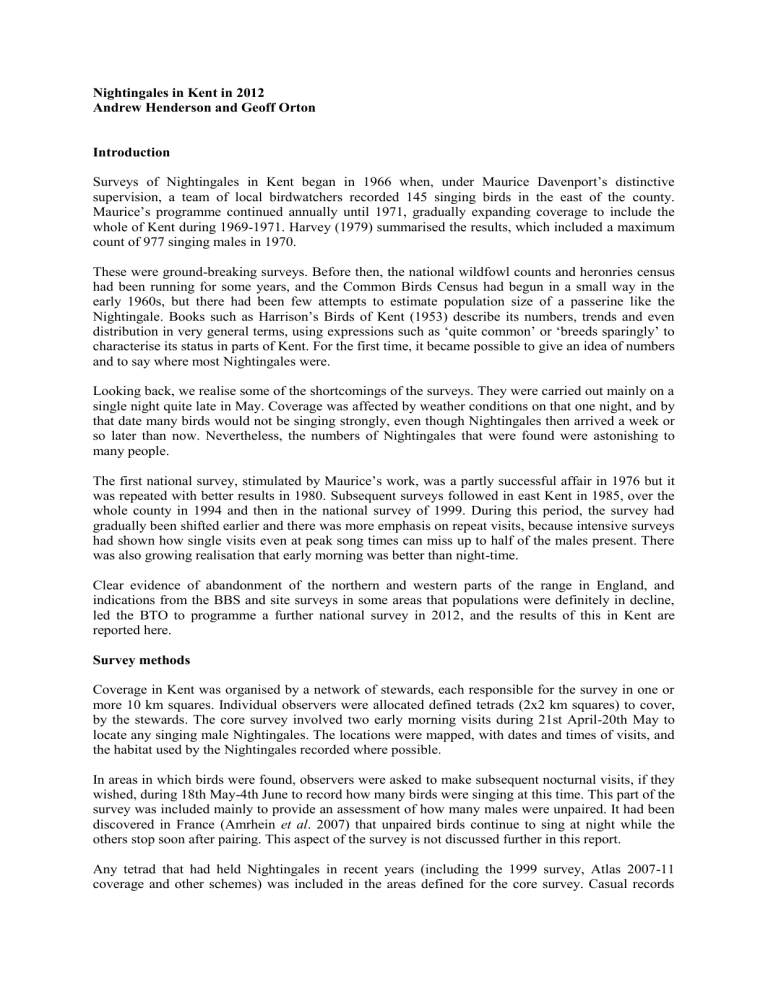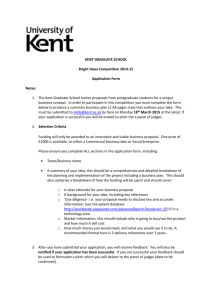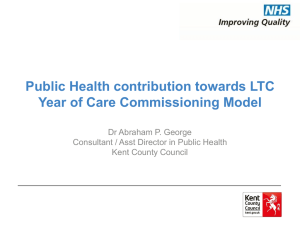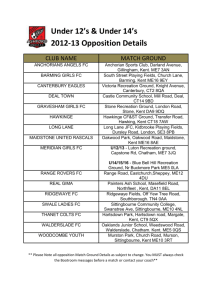KBR Nightingale 2012 report- Henderson and Orton

Nightingales in Kent in 2012
Andrew Henderson and Geoff Orton
Introduction
Surveys of Nightingales in Kent began in 1966 when, under Maurice Davenport’s distinctive supervision, a team of local birdwatchers recorded 145 singing birds in the east of the county.
Maurice’s programme continued annually until 1971, gradually expanding coverage to include the whole of Kent during 1969-1971. Harvey (1979) summarised the results, which included a maximum count of 977 singing males in 1970.
These were ground-breaking surveys. Before then, the national wildfowl counts and heronries census had been running for some years, and the Common Birds Census had begun in a small way in the early 1960s, but there had been few attempts to estimate population size of a passerine like the
Nightingale. Books such as Harrison’s Birds of Kent (1953) describe its numbers, trends and even distribution in very general terms, using expressions such as ‘quite common’ or ‘breeds sparingly’ to characterise its status in parts of Kent. For the first time, it became possible to give an idea of numbers and to say where most Nightingales were.
Looking back, we realise some of the shortcomings of the surveys. They were carried out mainly on a single night quite late in May. Coverage was affected by weather conditions on that one night, and by that date many birds would not be singing strongly, even though Nightingales then arrived a week or so later than now. Nevertheless, the numbers of Nightingales that were found were astonishing to many people.
The first national survey, stimulated by Maurice’s work, was a partly successful affair in 1976 but it was repeated with better results in 1980. Subsequent surveys followed in east Kent in 1985, over the whole county in 1994 and then in the national survey of 1999. During this period, the survey had gradually been shifted earlier and there was more emphasis on repeat visits, because intensive surveys had shown how single visits even at peak song times can miss up to half of the males present. There was also growing realisation that early morning was better than night-time.
Clear evidence of abandonment of the northern and western parts of the range in England, and indications from the BBS and site surveys in some areas that populations were definitely in decline, led the BTO to programme a further national survey in 2012, and the results of this in Kent are reported here.
Survey methods
Coverage in Kent was organised by a network of stewards, each responsible for the survey in one or more 10 km squares. Individual observers were allocated defined tetrads (2x2 km squares) to cover, by the stewards. The core survey involved two early morning visits during 21st April-20th May to locate any singing male Nightingales. The locations were mapped, with dates and times of visits, and the habitat used by the Nightingales recorded where possible.
In areas in which birds were found, observers were asked to make subsequent nocturnal visits, if they wished, during 18th May-4th June to record how many birds were singing at this time. This part of the survey was included mainly to provide an assessment of how many males were unpaired. It had been discovered in France (Amrhein et al . 2007) that unpaired birds continue to sing at night while the others stop soon after pairing. This aspect of the survey is not discussed further in this report.
Any tetrad that had held Nightingales in recent years (including the 1999 survey, Atlas 2007-11 coverage and other schemes) was included in the areas defined for the core survey. Casual records
also were invited, so long as clear information on location and date of the record were included, and some were retrieved from BirdTrack and similar schemes.
As well as the volunteer survey, several areas were chosen by BTO for intensive professional coverage, to provide more reliable estimates of Nightingale detectability and to facilitate other research on the species. In Kent, the one such area was on Forestry Commission land at Orlestone
Forest but similar coverage was arranged at Lodge Hill on the Hoo peninsula, to aid assessment of the implications of a major development proposal in the area and to extend volunteer cover there within a closed military compound.
Because of the poor weather and coverage problems in some counties, additional coverage including a small amount in Kent was organised in 2013. The additional information gained in Kent was minimal and the few records for that year have not been included in compiling this report.
Results
At least 120 people took part in the survey, and their dedication was often remarkable in one of the more dismal springs we have seen for years. It was persistently cool and wet through April and up to about 20th May, making for unpleasant and sometimes difficult surveys. The core coverage had initially been planned to end on 14th May but was extended for a week because of the weather and the birds’ late arrival. It is likely that the weather did reduce the numbers counted because birds were singing less vigorously and because surveyors were disheartened.
Despite the conditions, coverage was good. Most core tetrads were covered and many of the remainder received some casual coverage. In some places, records were submitted by several people, and it was necessary for the BTO, in conjunction with the local organisers, to assess how many separate territories existed. It is not always possible to be sure about this, even with many visits by a single observer, but a conservative approach was taken to determine the number present.
The total number of singing male Nightingales recorded in Kent in 2012 was 995. This includes birds found during the intensive coverage of Orlestone and Lodge Hill. Table 1 provides the number found in each 10 km square, and includes data for four previous surveys (one in east Kent only) for comparison. Figure 1 illustrates the distribution of birds by tetrad in 2012.
TQ44 2
TQ45 4
TQ46 0
TQ53 0
TQ54 12
TQ55 6
TQ56 3
TQ57 1
TQ63 3
TQ64 5
TQ65 3
TQ66 34
TQ67 0
TQ72 0
Figure 1. Distribution and abundance by tetrad of Nightingales in Kent in 2012
Singing males per tetrad: 1=small dot; 2-6=medium dot; 7-19=large dot; 20 or more=square
It is important to realise that the raw count is not the total Nightingale population of Kent. Some birds will not have been counted because of (a) areas not being visited, and (b) birds not singing during survey visits. An estimate of the total can be calculated, taking into account factors such as the number present in previous surveys in areas not visited, the rate of change in areas that were covered, and measures of detectability gained from intensive survey work. We have not attempted to do this independently for Kent, but rely on the statistical treatment of the data, at national and county levels, by the BTO. Unfortunately, the final results of this work were not available as this report was finalised but details will be published on the KOS website in due course.
Table 1. Distribution of Kent Nightingales by 10km square
The table shows the number in each square. nc = no count
1980 1985 1994 1999 2012 1980 1985 1994 1999 2012 nc nc nc nc nc nc nc nc nc nc nc nc nc nc
13
25
18
7
1
6
0
1
3
3
5
2
0
1
2
32
13
2
2
1
5
2
1
1
14
3
0
0
1
67
1
6
7
0
4
0
0
0
11
1
0
0
TQ73 2
TQ74 1
TQ75 10
TQ76 51
TQ77 48
TQ82 0
TQ83 15
TQ84 3
TQ85 12
TQ86 6
TQ87 0
TQ92 0
TQ93 65
TQ94 13 nc nc nc nc nc nc nc nc
59
6
68
11
43
11
9
48
82
2
62
21
43
23
15
93 nc nc nc nc
10
14
4
6
23
5
9
5 nc 103 130 154 nc 45 52 38
5
9
4
0
8
13
9
62
161
5
36
23
1980 1985 1994 1999 2012
TQ95 22
TQ96 0
TQ97 0
TR01 3
TR02 0
TR03 69
TR04 28
TR05 83 nc nc
24
75 nc nc nc nc
0
28
22
80
13
7
0
0
0
35
9
96
39
15
0
0
TR06 15
TR07 0
TR13 11
TR14 75
16
0
3
39
17
0
13
26
24
0
9
23
22
0
3
3
TR15 121 82 84 111 78
TR16 113 135 148 101 108
0
29
7
18
0
27
0
5
1980 1985 1994 1999 2012
TR23 4
TR24 48
TR25 34
TR26 2
TR34 1
TR35 3
TR36 0
TR37 0
5
45
34
4
1
4
0
0
0
41
34
22
2
4
3
0
0
15
21
50
1
3
17
0
Kent 931 nc 1066 1212 995
E Kent 538 467 496 480 309
Changes in numbers
The count of singing male Nightingales in 1999 was 1,212. This suggests that there was an 18% decline by 2012, when 995 were counted. This estimated decrease should be qualified by pointing out that differences in coverage and weather, and some survey differences (notably the greater emphasis on daytime visits in 2012) will have led to different proportions of the total population being located.
We cannot say how different these proportions were, since it is not possible retrospectively to apply the same correction to 1999 data as applied to the 2012 data. A cruder estimate of the total population in 1999 was that it fell in the range 1,450-1,575 but this may have been an under-estimate.
Figure 2 shows the changes recorded in each tetrad. There are some distinct patterns in this. One that was noted after the 1999 survey is the loss of birds from the Downs, in a wide swathe across the county from TQ46 in the west through TQ95 to TR34 in the east. Nightingales still occur in this region in the river valleys but they have now almost completely abandoned the higher and drier ground. The changes in TQ85 and TQ95 south of Rainham and Sittingbourne, TR05 west of
Canterbury and TR24 near Dover are especially striking, as they have lost many or in some cases all of what were substantial totals in 1999. Other areas with marked declines are TQ73 & TQ83 in the
Weald from Tenterden to Goudhurst, and the Medway gap around New Hythe and Eccles mainly in
TQ76 (although there are still large numbers in this area).
0
2
3
0
2
0
20
43
Figure 2. Changes in numbers of Nightingales in tetrads in Kent between 1999 and 2012
Dark symbols are gains, pale symbols are losses, open circles show no change.
Size of change: 1=small dot; 2-3=medium dot; 4-9=large dot; 10 or more=square
Significant increases are more restricted. One of the strongest was along the Medway valley downstream of Tonbridge. On the Hoo peninsula, especially TQ77 near Chattenden and High
Halstow, a large increase has reinforced this area’s position as one of the county’s strongholds. South of Ashford, near Warehorne and Shadoxhurst, lies another stronghold in TQ93, although here there are tetrads with major losses as well as those contributing to the net gains.
It is noteworthy that despite the presence of a strong population in the Blean and along the Stour valley, east Kent (comprising 10 km squares TR04-TR36) suffered a 36% decrease in numbers counted between 1999 and 2012, whereas the rest of the county experienced a mere 6% decline. If the comparison is made between 1994 and 2012, the difference is even more marked, with east Kent down by 38% but the rest of the county up by 20%. Some of this may be accounted for by efficiency of coverage but it seems likely that it reflects a real change.
Habitat
Habitat information was provided by surveyors for 867 of the 995 territories, and is summarised in
Table 2.
Table 2. Habitat use of Nightingales in Kent in 2012
The table includes comparable data for previous years with some categories combined in 1980 and 1994.
Sample sizes (n) omit territories in unknown habitat.
1980 1994 1999 2012 n 920
%
916
%
1191
%
867
%
Broad-leaved woodland 22.4 19.9 24.5 16.4
Coppice woodland
Coniferous woodland
Mixed woodland
New plantations
37.2 44.3 18.0 13.7
1.9 1.2
24.8 4.0 4.2 0.6
3.4 3.2
Scrub
Carr
38.8 51.2
1.3 3.9
Old orchards
Gardens
Hedges
12.8 25.7
2.8 6.1
1.2
1.2
5.5
0.3
0.9
8.4
The shift from coppice woodland to scrub as the primary habitat, first recognised in the 1985 east
Kent survey (Henderson 1987) and a striking feature of the changes between 1980 and 1999 nationally (Wilson et al . 2002), has continued. Scrub and closely allied vegetation types (carr, overgrown gardens, orchards and hedges) now account for 65% - almost two-thirds – of Kent
Nightingale territories.
As scrub occupancy has increased, the use of woodland types has declined. Very few are now in plantations that include conifers, which in 1980 held 25% of birds; this is largely a reflection of the decline of new plantings of this type. Mature broad-leaved woodland and coppice between them still hold 30% of Kent Nightingales but, for both categories, use has fallen. There may be several reasons for this. Most importantly, as described in the report of the 1999 Kent survey (Henderson 2002), the area of active coppice, especially that of the favoured mixed native species, has declined. It is the dense low cover provided by coppice, and the abundant invertebrate fauna it supports, that make – or made – it suitable for Nightingales. As woodland matures, this dense cover is lost, remaining only at woodland edges and around clearings or rides. Other factors such as dampness and food availability
(see below) could be involved, and perhaps are part of the suite of changes in the wider countryside that are linked to climate change. Increases in deer-browsing, believed to be a significant factor elsewhere in England, may now be an issue in Kent although deer numbers remain relatively low.
As habitat preference has changed, there has been a tendency for Nightingales to occur at lower altitude. This was demonstrated for the changes between 1994 and 1999 for the whole county, and between 1985 and 1999 for east Kent (Henderson 2002). The change between 1999 and 2012 has not yet been analysed, but cursory examination of the results suggest that the change was less marked than in the earlier period.
An association with wetland features is now strong. We cannot provide comparable figures for previous surveys but in 2012, for 48% of the 867 territories for which information was provided, the presence of pond, stream, river, canal or reedbed within 50m was mentioned. We are not sure of the reason for this association, which would not have been the case when the majority of birds were in woodland and at high elevations. It may simply be a reflection of the lower altitude of territories, or it could be linked with better vegetation density or food supply in damper places.
Important areas
Table 1 and Figure 1 show the distribution of Nightingales in Kent in 2012, illustrating where most occur. The number of occupied tetrads (2x2 km squares) fell from 257 to 210, but the average number of singing males in each was unchanged, at 4.7.
There were six tetrads in which 20 or more singing males were found. These were:
TQ93X Birchett, Longrope & Faggs Woods 53
TQ77L Great Chattenden-Lodge Hill 44
TQ76A New Hythe-Snodland
TQ15U Old Park, Canterbury
44
37
TR16M Thornden Wood north 20
TQ77R Lodge Hill-Deangate 20
It should be noted that those in TQ77 and TQ93 were subject to intensive professional survey, but the counts provided by volunteers alone already demonstrated these tetrads’ importance.
Definitions of areas by tetrad do not necessarily reflect discrete Nightingale populations, as they may span disjunctions of habitat, topography or land use. However, deciding the boundaries of appropriate areas for which to show totals is not straightforward, especially in parts of Kent such as the woodlands of the southern Weald or Blean. Table 3 gives totals for areas considered notable in 1999
(Henderson 2002), but modified by the addition of Northward Hill and its surroundings, the Murston-
Conyer area and Seaton gravel pits, each of which have gained Nightingales since 1999, and also by the Warehorne-Shadoxhurst area. The last is a large area including Faggs-Birchett Woods and which has gained significant numbers.
Table 3. Notable concentrations of Nightingales in 2012
1999 2012
Chattenden Woods-Upnor
Warehorne-Shadoxhurst
Medway valley, Tonbridge-Yalding
Faggs, Longrope & Birchett Woods, Warehorne
New Hythe-Eccles
Church Wood (Canterbury) complex
Lower Higham-Cliffe
Old Park, Canterbury
Clowes/Thornden/Honey Woods
Stour valley, Sturry-Grove
West Blean Wood
Northward Hill-Eastborough
Kemsley-Conyer
Woods south of Pluckley (Dering-March)
Seaton gravel pits
Trenleypark Wood area
Goudhurst-Bedgebury
Benenden-Hemsted
Down Wood complex
Holborough-Burham-Wouldham
East Blean Wood
Denstead Wood complex
Woods N of Ruckinge (Dickers-Pierland)
11
52
4
33
22
22
35
23
16
32
24
46
67
29
60
67
48
23
29
32
36
25
12
26
24
17
8
8
7
7
7
7
5
3
91
76
63
56
52
52
45
37
34
30
29
27
Of the areas in Table 3, more experienced decreases than increases, as would be expected given the overall trend. There are many factors that will have led to changes in individual areas, but the most important is usually vegetation succession. Thus, for example, the area near Warehorne has maintained (or, in the case of the expanded area, gained) numbers while that near Ruckinge has lost most of them. The former includes the Forestry Commission’s Orlestone Forest, in which a programme of replanting and especially mechanical management (by mulching) of some areas specifically for Nightingales has maintained much suitable habitat. In contrast, at Dickers and
Piersland Woods, large areas had been coppiced a few years before 1999, creating suitable conditions then, but little subsequent management has taken place.
Nightingale numbers in the Blean woodlands and Stour valley have changed little, aided by much nature conservation management in the woods, and the continuing presence of damp scrub in the valley. In the Medway valley downstream of Tonbridge and in the Murston-Conyer area, growth of scrub close to wetlands has allowed larger populations to develop, although in the latter it is possible that some were missed in 1999. The Down Wood area, on the chalk, and the Goudhurst and Benenden areas have probably become less suitable because of the maturation of woodland, accentuated in the first case at least by dry conditions. Woodland maturation has certainly been a major factor at the woods near Pluckley and at Trenleypark Wood.
The drop in numbers in the Medway gap, especially around Holborough, is less easy to explain, although scrub growing too tall and in some cases being cleared may be involved. Detailed study of individual sites would be needed to confirm controlling factors, and the suggestions put forward here are merely the most likely.
The area in which there has been the most consistent increase is the Hoo peninsula. There have been large increases between Cliffe and High Halstow, mainly on RSPB land where scrub has been encouraged to establish, and in the Chattenden area, where scrub has developed on a largely disused military site and coppicing of damp mixed-species stands, partly for game management, has retained suitable habitat in the woodlands. However, there have been losses even on the peninsula: a cluster present in 1999 at Kingsnorth power station was lost when the scrub was cleared to improve site security during environmental protests, and there have been local declines in areas where scrub or woodland has grown too tall to suit Nightingales.
The Chattenden area held the largest total within a discrete and relatively small area, and this was recognised in March 2013 when 350 ha were notified as a Site of Special Scientific Interest by
Natural England. Among the reasons for notification was that it supported a nationally important breeding population of Nightingales, the first occasion when a site has been selected specifically for this species.
National context
In our previous report, we mentioned that BTO had provided a provisional estimate of the national population of Nightingales (6,250-6,550 singing males). This was calculated before all data were input and validated, and before all statistical procedures were developed to account for (a) birds that did not sing during survey visits and (b) areas that were not covered. The provisional estimate was considered likely to be an over-estimate (BTO unpublished report, January 2013).
That estimate of the population has now been refined but at the time of going to press had not been finalised. A number of different statistical treatments have produced estimates ranging upwards from about 5,800 singing males (per BTO, June 2015) and it seems that the mid-point will be below that of the provisional estimate, though not by a large amount.
BTO have not been able to provide estimates of individual county populations in 2012. However, applying the same multiplier as between the count (i.e. the number actually located) and the estimate nationally to the Kent count (in both cases excluding casual records) would suggest a Kent population of 1,502-1,533 singing males (25.9% of the national total). This is not necessarily accurate, since coverage differed between counties. An alternative approach, comparing the total count in Kent with the national count (in both cases including casual records), suggests that Kent held 25.3% of the total.
This also is possibly biased by differences in survey efficiency but would imply 1,467-1,497 singing males in Kent. We therefore suggest that the county population in 2012 should be considered to be in the range 1,450-1,550 with a midpoint of 1,500.
The outlook
In conclusion, we speculate on the prospects for the Nightingale in Kent. Given the downward trend nationally, now evident in Kent if it was not before, and the range of threats the species has to face, is difficult to be optimistic. A few of the more pressing problems are outlined below; more detailed information on national and international issues can be found in, for example, Holt et al . (2013).
There is continuing retraction into south-east England, with populations on the edge of the range increasingly restricted to isolated clusters which seem to lack the ability to colonise other nearby areas. This may be because low productivity, in years with poor weather such as 2012, exacerbated by losses on migration or in Africa, mean that not enough birds are available to colonise newly available habitat (such as young scrub or recently cut coppice). Social factors may be involved with this, in that the later-arriving females may be more likely to choose places with several singing males, resulting in clusters or loose colonies.
Threats that are of direct relevance to Kent include:
Habitat change
Further decline in the coppicing of suitable woodland
Continuing changes in woodland ecology, involving factors potentially critical to Nightingale success, such as shrub layer density and invertebrate abundance. We do not understand which of these factors are most important nor, in many cases, why they are happening, although climate change and growing deer numbers may be implicated.
Maturing of existing areas of scrub, thus becoming less suitable for Nightingales, with less similar areas becoming established. There is little knowledge of how to manage scrub for species such as Nightingale, in the long term.
Habitat loss
Removal of scrub in the belief that it is wasteland or to create amenity areas. There is a risk that this could happen, for example, in the Leybourne Country Park in the Medway gap, where maintenance of large enough areas of suitable scrub may be difficult in the context of public access provision. There are a few areas where scrub is currently developing on low-intensity or abandoned agricultural land; these too could easily be restored to more intense use.
Building of residential or industrial property. Examples of where this could occur include the
Medway gap and the Chattenden area, but regrettably nowhere in Kent is safe
The proposal for a development of 5,000 houses and associated infrastructure at Lodge Hill,
Chattenden, was a major conservation issue as this report was prepared. This survey and its predecessors have provided invaluable data to inform decisions in the case of this proposal, not least in demonstrating the site’s national importance, resulting in its SSSI status. The outcome is currently far from certain but we know that it will not be the last time that Nightingales face possible unwarranted eviction.
There are some reasons for hope. Among the developments that might benefit Nightingales are:
An increase of coppicing, especially of mixed native species, stimulated by growing nature conservation ownership and management of woodland, and possibly a growing demand for wood fuel. There has been a modest upturn in sweet chestnut coppicing; while chestnut tends to be less suitable than other species, sufficient areas – especially where containing other tree species or bramble – might attract Nightingales.
Greater willingness to take opportunities provided by the accidental development of scrub in post-industrial or agricultural settings. The promotion of better appreciation of the value of scrub would help in this respect, and there is also the need for better understanding of how to manage the habitat in the long term. Examples of what might be involved are better patterns of mixed use (e.g. recreation & nature conservation) around gravel pits, and the inclusion of scrub development and management in agri-environment schemes.
Nightingales are now too scarce for population trends to be tracked reliably using the BBS, and the
KOS and individual birders can play a valuable role by recording, in a consistent manner, the numbers within defined areas. Monitoring populations in newly colonised or re-colonised areas, including developing scrub or restored coppice, also is desirable. We can also help by giving advice and support to nature conservation bodies such as the Kent Wildlife Trust and RSPB over land management and planning issues, and becoming personally involved when development proposals threaten important
Nightingale areas.
Acknowledgements
Special thanks are due to the 36 stewards who devoted much time to persuading surveyors to venture out in the rain, and in many cases undertook a large part of their area’s coverage themselves. All of the 130 or more people who took part will, we hope, be pleased to see this summary of their efforts and to know they contributed to a successful survey. We are also grateful to the British Trust for
Ornithology (and specifically to Greg Conway, John Marchant and Chris Hewson) for much help with survey organisation, answering many queries during spring 2012, and making available the full set of results for Kent. Tim Hodge prepared the maps as promptly as ever, using the DMAP mapping software supplied by Dr A J Morton. Helpful comments on an earlier draft were made by Owen
Sweeney and Murray Orchard.
References
Amrhein, V., Kunc, H.P., Schmidt, R. and Naguib, M. (2007) Temporal patterns of territory settlement and detectability in mated and unmated Nightingales Luscinia megarhynchos . Ibis
149: 237-244.
Balmer, D.E., Gillings, S., Caffrey, B.J., Swann, R.L., Downie, I.S. & Fuller, R.J. (2013) Bird Atlas
2007-11: the breeding and wintering birds of Britain and Ireland. BTO Books, Thetford.
Harvey, W.G. (1979) The Kent Nightingale Surveys. Kent Bird Report (1977) 26: 98-99.
Henderson, A.C.B. (1987) Nightingales in East Kent in 1985. Kent Bird Report (1985) 34: 83-87.
Henderson, A. (2002) Nightingales in Kent in 1999. Kent Bird Report (2000) 49: 161-175.
Holt, C.A., Hewson, C.M. and Fuller, R.J. (2013) The Nightingale in Britain: status, ecology and conservation needs. British Birds 105: 172-187.
Wilson, A.M., Henderson, A.C.B. and Fuller, R.J. (2002) Status of the Common Nightingale Luscinia megarhynchos in England at the end of the 20th Century with particular reference to climate change. Bird Study .






